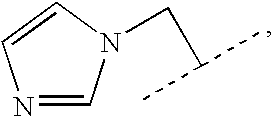Viral Polymerase Inhibitors
a polymerase inhibitor and polymerase technology, applied in the field of hcv polymerase, can solve the problem of no vaccine to prevent hcv infection, and achieve the effect of improving the inhibitory activity of hcv polymeras
- Summary
- Abstract
- Description
- Claims
- Application Information
AI Technical Summary
Benefits of technology
Problems solved by technology
Method used
Image
Examples
specific embodiments
[0162] Included within the scope of this invention are all compounds of formula I as presented in Tables 1 and 2.
Polymerase Activity
[0163] The ability of the compounds of formula (I) to inhibit RNA synthesis by the RNA dependent RNA polymerase of HCV can be demonstrated by any assay capable of measuring RNA dependent RNA polymerase activity. A suitable assay is described in the examples.
Specificity for RNA Dependent RNA Polymerase Activity
[0164] To demonstrate that the compounds of the invention act by specific inhibition of HCV polymerase, the compounds may be tested for inhibitory activity in a DNA dependent RNA polymerase assay.
[0165] When a compound of formula (I), or one of its therapeutically acceptable salts, is employed as an antiviral agent, it is administered orally, topically or systemically to mammals, e.g. humans, rabbits or mice, in a vehicle comprising one or more pharmaceutically acceptable carriers, the proportion of which is determined by the solubility and ...
example 1
[0190]
Methyl 3-amino-4-iodobenzoate
[0191] 3-Amino-4-iodobenzoic acid (13.35 g, 50.8 mmol) was added to MeOH (150 mL) and SOCl2 (4.8 mL, 65.8 mmol, 1.3 equivalent) was added. The mixture was refluxed for 3 h and then volatiles were removed under reduced pressure. The residue was co-evaporated three times with MeOH and dried in vacuo (15.23 g).
Methyl 3-trifluoroacetamido-4-iodobenzoate
[0192] The aniline derivative from above (14.53 g, 52 mmol) was dissolved in DCM (200 mL) and TFAA (15 mL, 104 mmol) was added. The dark purple solution was refluxed overnight. Volatiles were removed under reduced pressure and the residue was passed through a short pad of silica gel using DCM as eluent. The desired product was obtained as a pink solid (13.81 g).
4-Phenylethynyl-3-(2,2,2-trifluoro-ethanoylamino)-benzoic acid methyl ester
[0193] The iodide from above (0.742 g, 2 mmol), phenylacetylene (0.37 mL, 3.9 mmol, 1.7 equivalent) and Et3N (6 mL) were charged in a dry flask under argon. PdCl2(PPh3...
example 2
[0198]
3-Cyclohexenyl-6-indole carboxylic acid
[0199] A 12 L round-bottomed flask was equipped with a reflux condenser and a mechanical stirrer, and the system was purged with nitrogen gas. 6-Indole carboxylic acid (300.00 g, 1.86 mole, 3 equivalents) was charged into the flask, followed by MeOH (5.5 L). After stirring for 10 min at room temperature, cyclohexanone (579 mL, 5.58 mole) was added. Methanolic sodium methoxide (25% w / w, 2.6 L, 11.37 mole, 6.1 equivalents) was added in portions over 10 min. The mixture was then refluxed for 48 h. After cooling to room temperature, water (4 L) was added and methanol removed under reduced pressure. The residual aqueous phase was acidified to pH 1 with concentrated HCl (˜1.2 L). The resulting yellowish precipitate was collected by filtration, washed with water and dried under vacuum at 50° C. The desired cyclohexane derivative was obtained as a beige solid (451.0 g, 100% yield).
3-Cyclohexyl-6-indole carboxylic acid
[0200] The unsaturated der...
PUM
 Login to View More
Login to View More Abstract
Description
Claims
Application Information
 Login to View More
Login to View More - R&D
- Intellectual Property
- Life Sciences
- Materials
- Tech Scout
- Unparalleled Data Quality
- Higher Quality Content
- 60% Fewer Hallucinations
Browse by: Latest US Patents, China's latest patents, Technical Efficacy Thesaurus, Application Domain, Technology Topic, Popular Technical Reports.
© 2025 PatSnap. All rights reserved.Legal|Privacy policy|Modern Slavery Act Transparency Statement|Sitemap|About US| Contact US: help@patsnap.com



